 | |
           2024 Sistema Cheve |
2023 Sistema Cheve Expedition: The Backdoor
Objectives Similar to the 2022 reconnaissance expedition, there were two work locations: Cueva Cheve and vicinity, and the area around San Miguel Santa Flor (SMSF) which is located directly above the current end of exploration in Cheve. The team working from Cheve basecamp planned to conduct and support an “alpine-style” lightweight return to the bottom of the cave and establish Camp 7B. The SMSF team planned to focus primary efforts on extending the bottom of Cueva Palomora (known locally also as Osto Agua Pajarito). There was also be collaboration with the Cheve team on a radio location effort to lock in the position of passages at the end of Cheve that are closest to the surface - the objective being to find an entrance that would decrease travel time to the Camp 6 and 7B areas and their associated unexplored tunnels. Additional efforts based out of SMSF were to focus on ridewalking. Cheve Alpine Push: It is nearly 12 kilometers of one-way travel from the Cheve entrance to the current limit of exploration. Despite a month of effort based from Camp 6 in 2021 – following 2-1/2 months of effort to get to that point – the team did not find the way on beyond Harmony Hall. Nor did we see the Cheve river beyond Camp 3. An extraordinary logistics pipeline is required to sustain an exploration team at Camp 6. Given our current state of knowledge an effective effort to find the way onwards would require a 3 or more month expedition. An alternative concept emerged in May 2022. The idea was to field a lightweight, fast “alpine” style effort in 2023 with a small team for the specific purpose of scaling the XEE16 waterfall that enters the cave at the northwest limits of the system. This shaft series leads upwards and had already (in 2021) been scaled to a point just 330 m below the surface of the stream bed that passes through SMSF. There is strong airflow going up the shaft series, suggesting a connection with the surface. This is the closest point Sistema Cheve has ever been to the surface and it may be a possible “backdoor” to the system that would eliminate the current 5 days of travel to Camp 7. Consequently, if we were successful with this highly directed push we could resolve the logistics problem and be able to directly focus on exploring northward towards the resurgence. To make this work in 2023 there were two separate groups supporting the effort: Team Alpine, led by members of the 2021 expedition that had worked beyond Camp 6 along with other expedition cavers familiar with the system beyond Camp 3. The team included skilled aid climbers who were also surveyors and sketchers. Alone, Team Alpine could not support itself for more than a few days. Thus Team Sherpa was organized to support Team Alpine. This mainly involved moving food, and some limited replacement equipment when needed, from basecamp to Camp 3 and possibly as far as Camp 5. For more on work done in 2021 and 2022, go to the USDCT downloads page. The top link is for the book written about the 2022 expedition by various members of the team. San Miguel Santa Flor: The main objective in the Santa Flor area was to continue exploration in Cueva Palomora. Cueva Palomora is located about half a kilometer east of the village of SMSF in a zone of sinkholes that continues eastward and overlies the other major Cheve area caves J2 and Cueva Charco. Palomora was pushed to -368 m depth in 2022. The cave is almost entirely vertical, with rope drops sometimes being separated by short sections of narrow canyon (“meanders”). The cave is warm (about 18C) and mostly dry. Exploration began in 2022 at the -230 m level and continued down a significant shaft series to the -348 m level. The bottom of the cave currently consists of a meander that gradually narrows into a hard rock layer (likely chert) to a dig. In 2022 we made close to 50 m of horizontal progress in the dig and dropped 20 m vertically. The passage carries very strong, cold, outward airflow. We stopped at a 7 m unexplored pit. This location is 137 m vertically above Harmony Hall in Cheve and is situated between Cheve and J2. GIS data clearly show a linear array of sinkholes on the surface that link Palomora with the end of the Calles de Papalo mega tunnel in Peña Negra, some 8 kilometers to the south, and displaced roughly 800 m east of the main Sistema Cheve fault. These sinkholes suggest that Palomora could be headed towards the continuation of the main (and still undiscovered) Peña Negra tunnel. The airflow, combined with Palomora’s auspicious location, make it the second serious contender for a back door to Sistema Cheve. 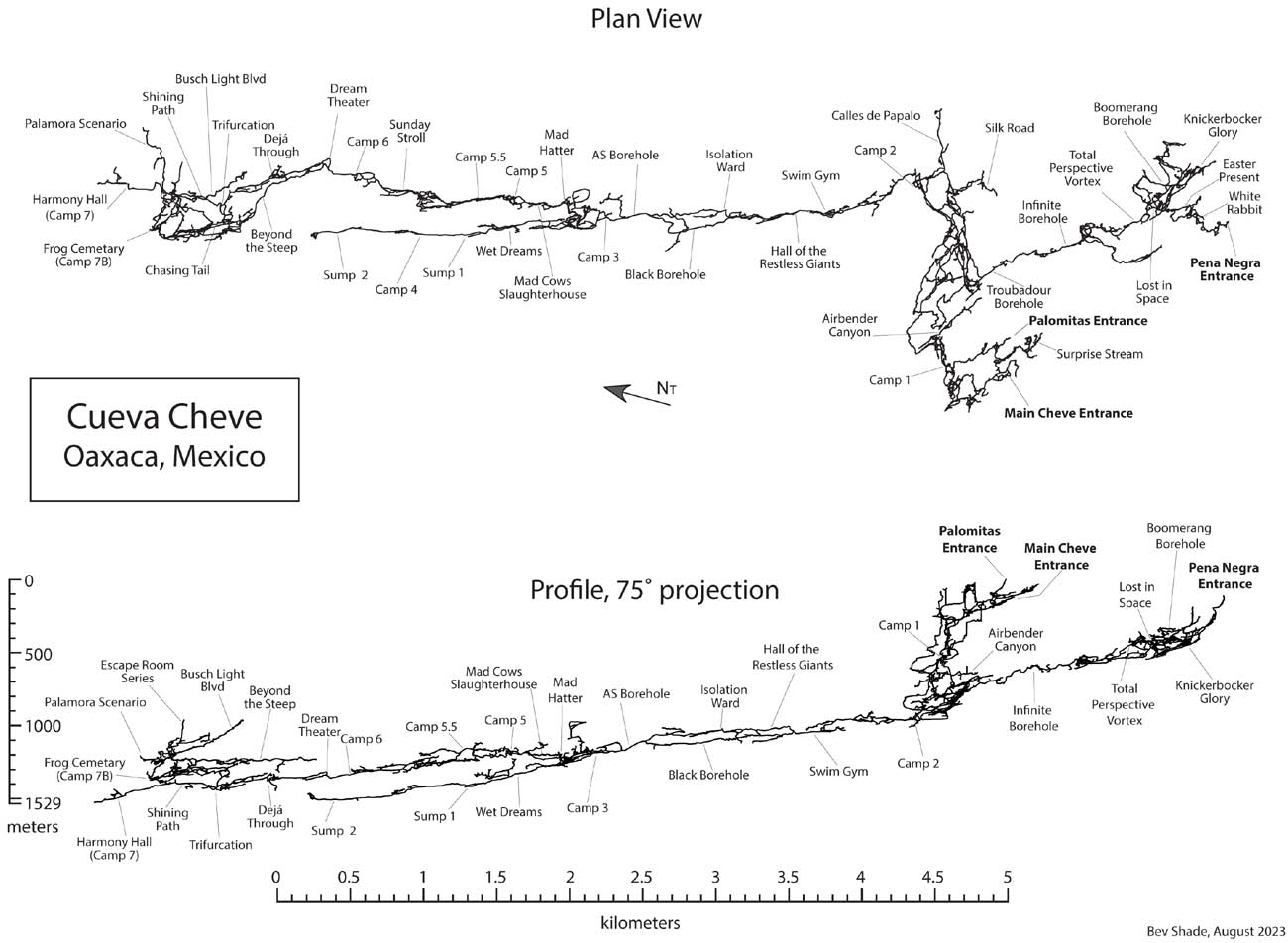
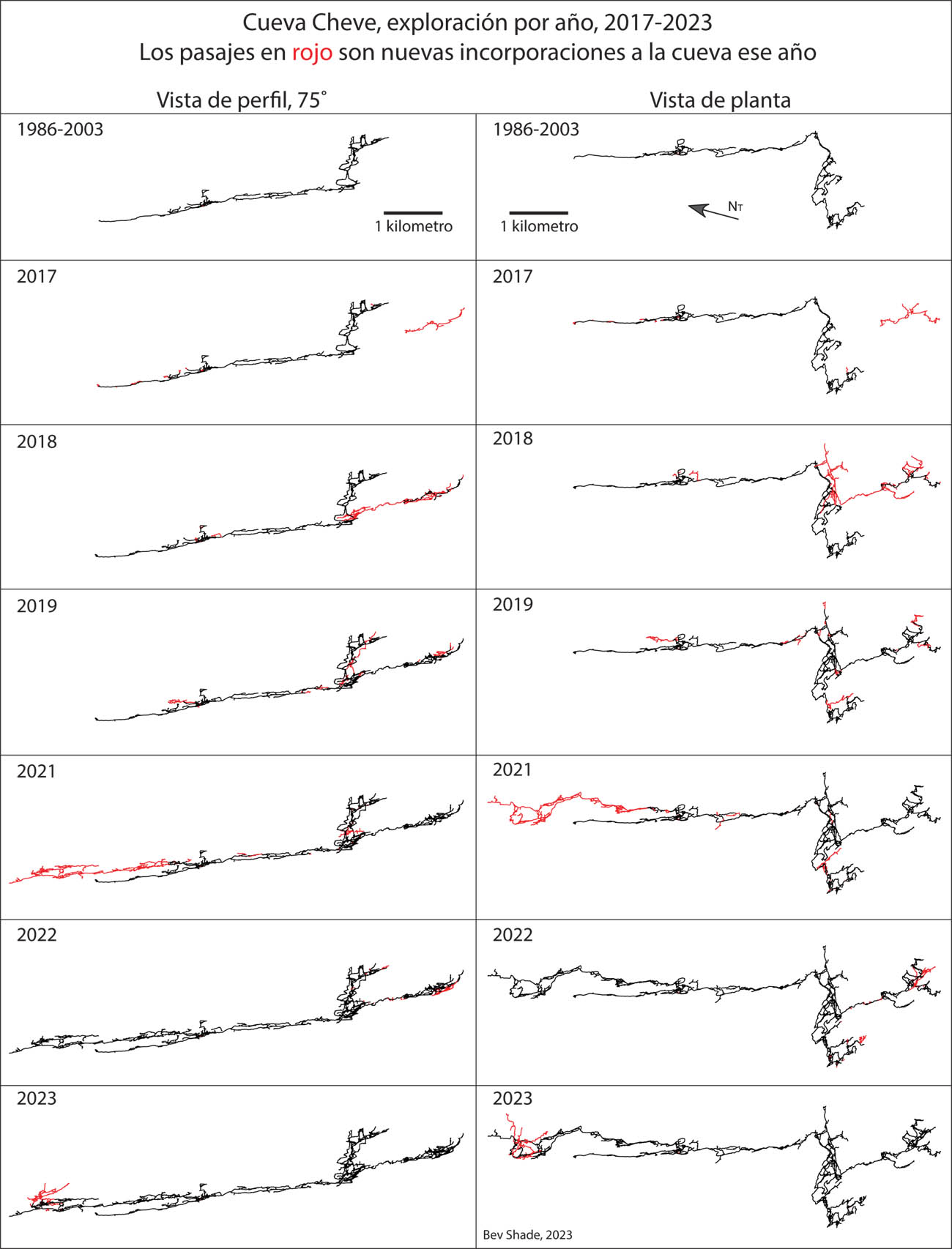
Expedition Results In 2023 there were three pushes from Camp 7B, set near the Frog Cemetery in the connecting tunnel between the Shining Path borehole and the higher level Chasing Tail tunnel (all at the far northern limits of Cheve). These efforts were initially focused on continuing the ascent of the XEE16 waterfall series that was begun in 2021. It is believed that the source of the XEE16 water is the surface arroyo near SMSF in the middle karst, 1,100 m lower in elevation than the Cheve entrance. The hope was that by scaling the waterfall it might be possible to locate a “back door” entrance to Cheve and eliminate the 5 day transit time from the original entrance to C7B. Instead, a dry paleo labyrinth was discovered leading up, east, and south of the waterfall starting approximately 100 m above C7B. In all, seven kilometers of new cave were discovered in this area in 2023 extending to, in some places, more than 400 m vertically above C7B and reaching within 100 m of the surface. 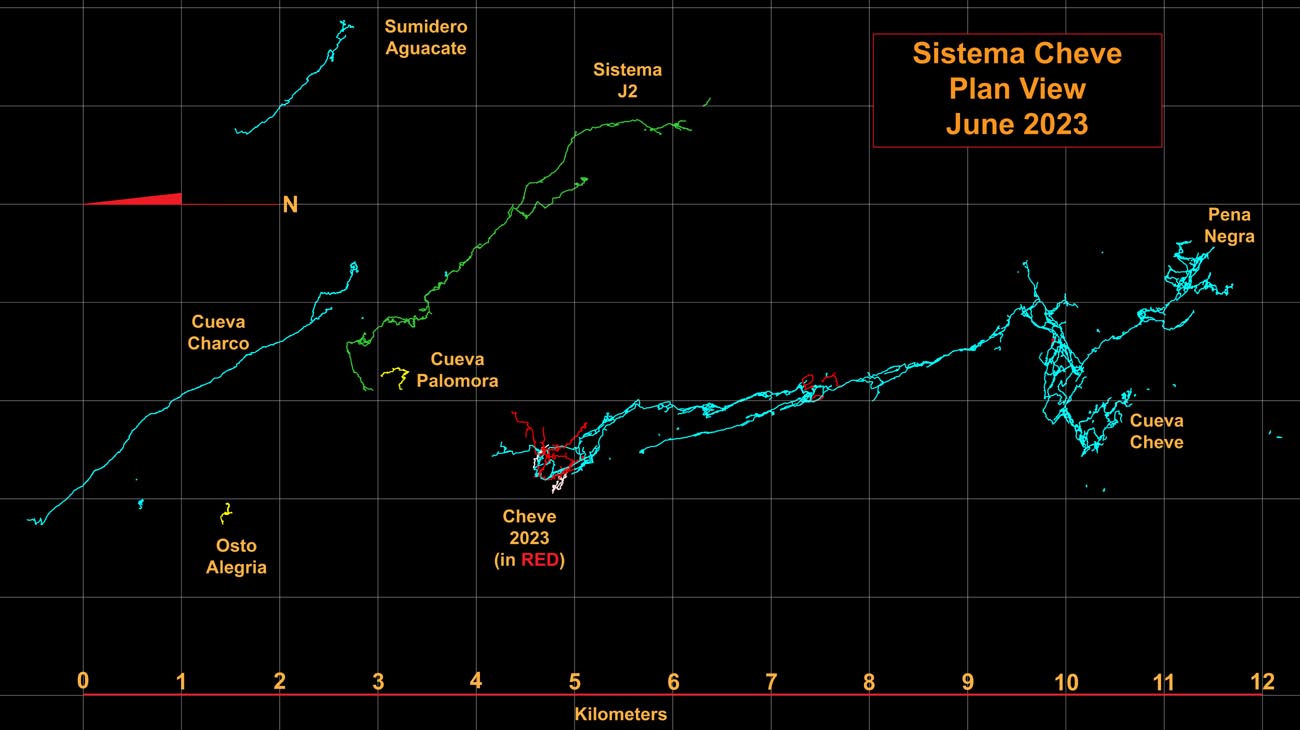
Three passages discovered in 2023 in the paleo labyrinth above C7B are of particular interest. The SLD/SNH survey – up the “Escape Shaft” – comes very close to the surface and may suggest a connection with a new entrance near SMSF. The SNB/SFD/SRB tunnel climbs steadily to the south, gaining more than 225 m in elevation. It appears to be aimed at possible entrances in the upper Aguacate canyon, above the Last Bash entrance to J2. Finally, the SLG/ SLH tunnel, discovered late in the expedition, heads resolutely east and currently reaches a point more than 400 m east of the Shining Path borehole. Importantly, there is strong wind in this passage, blowing outwards. 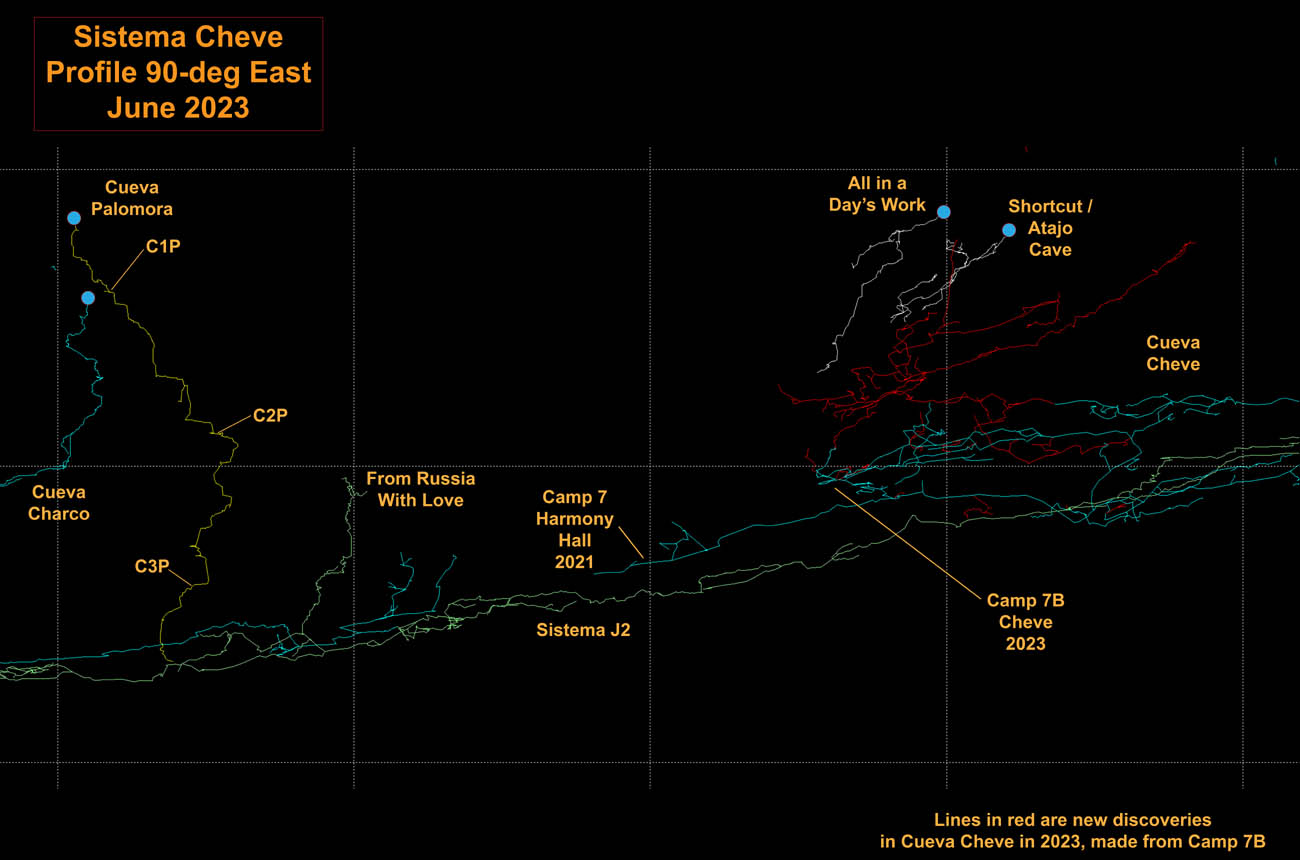
At the start of the 2023 expedition Cueva Palomora was 368 m deep and the limit of exploration was a 7m pitch at the end of a 40m long crawlway known as the Ant Tube. A sustained effort – ultimately involving 33 cumulative days in 2023 spent camped at or below camp C2P – resulted in a doubling of the depth of the cave to -734 m. The final pushes were based from camp C3P, set at the -610 m level. The end of Palomora is now level with the passages at the deepest point reached in J2 in 2013, beyond Sump 4. This is at a point 270 m southwest of the end of the air filled tunnels beyond Sump 4 in J2 with Palomora heading due west at the deepest point, not towards J2. Further, Palomora bypassed, by nearly half a kilometer horizontally, the From Russia with Love dome in J2, which was long expected to be the likely connection point. Air flow at the current limit of exploration in Palomora is a strong outward draft. It has this attribute in common with the promising SLG/SLH eastern tunnel in Cheve, suggesting that there is something very large between these two locations that is driving the wind. The most likely contender for this air source is the continuation of the main Peña Negra tunnel, lost in 2019 in the breakdown at the end of the massive Calles de Papalo tunnel, nearly 8 kilometers to the south. New, high resolution topographic maps, combined with the new geology map show a clear line of sinkholes from Calles de Papalo to Palomora. The current end of Palomora is now 150 m deeper than the deepest point in Cheve and more than 450 m deeper than the current limit of exploration in the SLG/SLH tunnel, suggesting that whatever tunnel exists between Palomora and SLG/SLH will not only be large, but also descending rapidly. 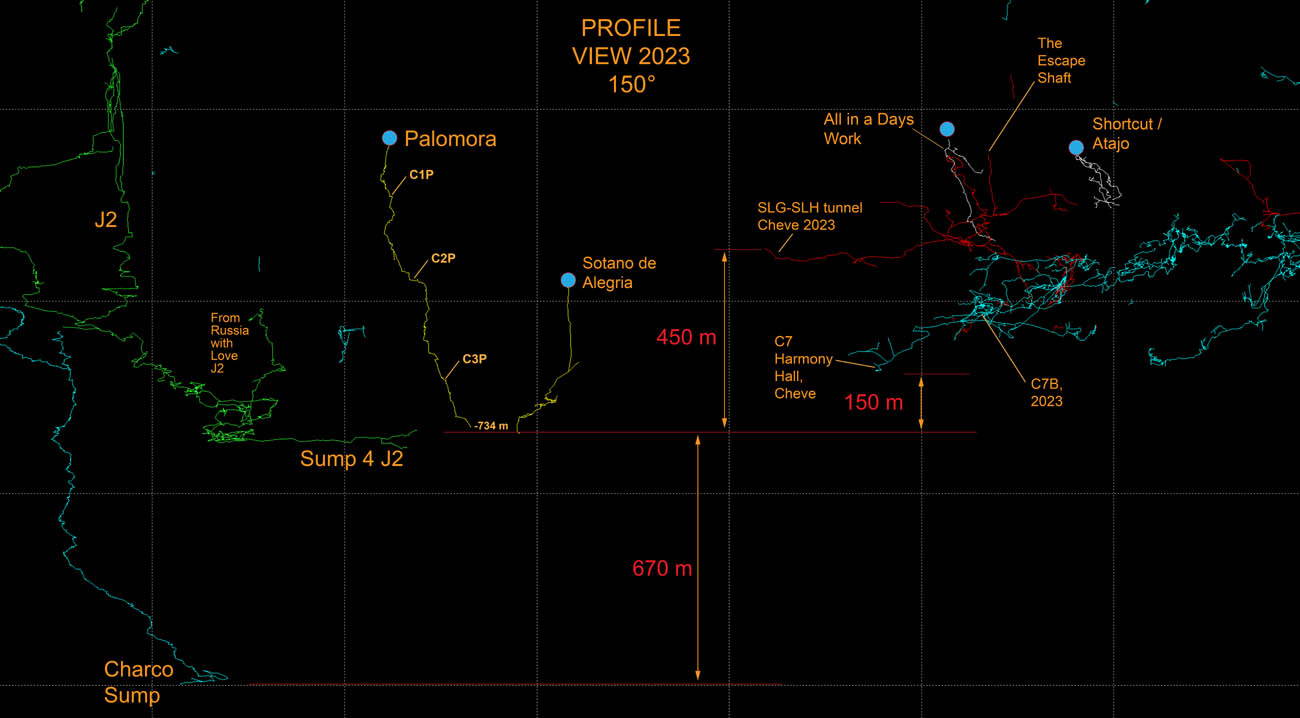
During the 2023 expedition we received extraordinary assistance from the local residents of San Miguel Santa Flor in locating new cave entrances, particularly those which had out-flowing air, regardless of entrance size. This rapidly led to the discovery of two completely new and highly promising caves that could prove to be alternative access routes to the deepest, most remote sections of Cueva Cheve. Shortcut Cave (Cueva Atajo) is located approximately 15 minutes walking upstream of the road water crossing in SMSF. It is currently 1,248 m long and 144 m deep. It appears to end in a large breakdown chamber. Unstable rock has thus far prevented further progress. Meanwhile, All in a Day’s Work (ADW) cave – located just 5 minutes walking from the road stream crossing – is currently 801 m long and 264 m deep. Exploration stopped at a deep pitch with wind blowing out. Portions of ADW come to within 50 m horizontally (as corroborated by a radio location performed through 250 m of overburden) of the labyrinth above Camp 7B in Cheve discovered in 2023. Finally, extended range surface reconnaissance work in 2023 near the village of Joya Durazno led to the discovery of Osto Alegria. This produced the deepest known pit in the Cheve karst: a 218 m entrance shaft. Alegria was subsequently pushed to a length of 916 m and a depth of 380 m where it has entered into a complex labyrinthine area. The entrance is approximately 2 kilometers north of SMSF and it effectively overlies the projected path of the main Cheve subterranean river (which has not been seen since Camp 3 in Cheve). |
| Copyright © 2025 U.S. Deep
Caving Team, Inc. All rights reserved. Todo el contenido tiene derechos de autor del U.S. Deep Caving Team. Todos los derechos reservados. No portion of these pages may be used for any reason without prior written authorization. | |

